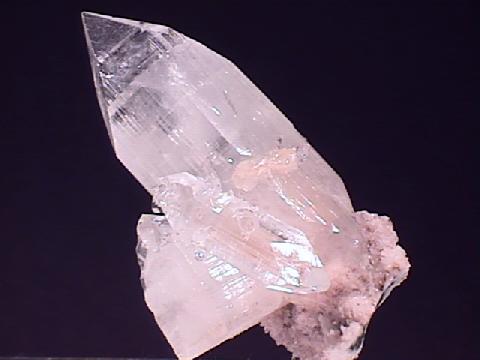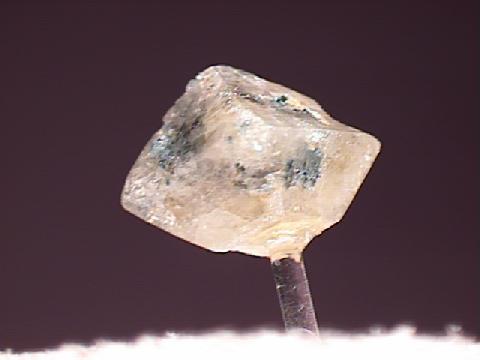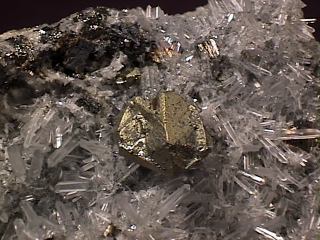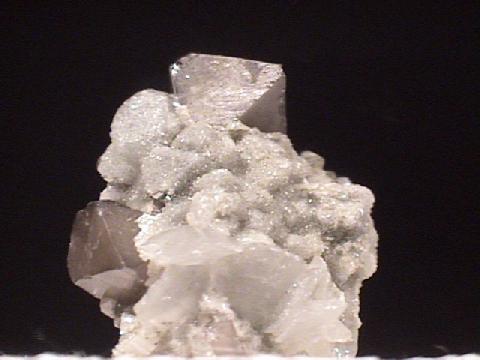SOME TETRAGONAL
MINERALS

ZIRCON

CARLETONITE

RUTILE

SCAPOLITE

ANATASE

VESUVIANITE

NARSARSUKITE

AUTUNITE

XENOTIME

THORITE

ZEUNERITE
|
The tetragonal system is the least populated by natural crystals
of all the crystallographic systems. The basic setup is similar to the
isometric system
in that all angles between the crystallographic axes are 90
degrees. The difference between the isometric system and the tetragonal
system is that one of the three axes is longer or shorter than the other
two. This produces a unique direction in the tetragonal crystals giving
rise to the reference of the tetragonal system as uniaxial. This unique
direction in the crystal becomes the major axis, also called the c
axis. The other two axes are identical and are referred to as a
and a'.
The basic form of the isometric system can be thought of as a square
box; however, in the tetragonal system the basic form can be thought of
as either an elongated or a flattened box. The box will still have a square
cross-section, but side profiles will show rectangles. The direction through
the square cross-section defines the four fold rotational axis, or the
c axis, that is required for this system. Tetragonal crystals that
have a box like form or a pyramidal form can be pseudo-
cubic
or pseudo-
octahedral,
respectively. This occurs if the major axis is similar in length to the
other axes or if the crystal simply did not grow fast enough or slow enough,
which ever the case may be, in the major axis direction.
The system's most symmetrical class, the Ditetragonal Dipyramidal
Class, has a mirror plane perpendicular to the major axis. Each of
the two identical crystallographic axes (a and a') serve
as the 2 two fold rotational axes. Two mirror planes are also found running
parallel to the major axis and are perpendicular to the two fold axes.
With all this symmetry, more symmetry is actually produced from the position
of the mirrors and axes. Two more two fold axes are found between the a
and a' axes in the plane perpendicular to the major axis. Also two
more mirror planes are found parallel to the major axis, again between
the other two mirror planes. The four separate mirrors divide the crystal
into 45 degree slices just as four cuts through a pizza divide it into
eight slices. The eight slices are an analogous representation of the ditetragonal
(or 2 X 4 sided) aspect of this class and the Ditetragonal Pyramidal
Class which lacks the perpendicular mirror and the two fold axes.
The other lower symmetry classes have few minerals as members and fewer
minerals that crystallize well enough to show their true symmetry. The
Tetragonal Scalahedron Class and the Tetragonal Disphenoidal
Class do not even appear to belong to the tetragonal system as they
seem to lack a four fold axis. They don't really lack a four fold axis,
it's just a four fold rotoinversion axis. A tetragonal rotoinversion
axis takes a face, rotates it 90 degrees (one fourth of a rotation)
and then inverts it (up to down & right to left) through the crystal
to the other side. Then it rotates it again 90 degrees and inverts it again
through the crystal. Another rotoinversion operation and finally another
(four in all) and it is back exactly where it started. The result is two
major faces on the top and two on the bottom of the crystal but in perpendicular
orientation. The axis then looks like a two fold axis instead of the four
fold axis that it actually is. The tetragonal scalahedron has eight faces
(four pairs) instead of the four faces of the tetragonal diphenoid, but
the symmetry operation is the same.
The other classes include the Tetragonal Trapezohedral Class
which lacks any mirror planes and is analogous to other trapezohedral classes
of other systems such as the
Trigonal Trapezohedral Class, 12th, (3 2) and the Hexagonal Trapezohedral Class, 19th, (6 2 2).
The Tetragonal Dipyramidal Class and the Tetragonal Pyramidal
Class simply have a four fold axis with no parallel mirrors or any
two fold axes. The difference between these last two classes is the presence,
or lack there of, of a perpendicular mirror plane. A dipyramid is just
a pyramid on top that is then reflected on the bottom.

Apophyllite
-
Class: 27th
-
Symmetry: 4/m 2/m 2/m
-
Symmetry Elements: There is 1 four fold axis, 4 two fold axes, 5
mirror planes each perpendicular to one of the rotational axes and a center.
-
Crystallographic Axes: Two axes, a and a' are equal
to each other, but they are either shorter or longer than the c
axis.
-
Angles: All three angles = 90 degrees.
-
Common Forms: The ditetragonal
dipyramid,
tetragonal dipyramid, ditetragonal
prism,
tetragonal prism and the basal
pinacoid.
-
Most Common Minerals Know to this Class:
Apophyllite,
autunite,
meta-autunite,
torbernite,
meta-torbernite,
xenotime,
carletonite,
plattnerite,
zircon,
hausmannite,
pyrolusite,
thorite,
anatase,
vesuvianite,
rutile and
cassiterite as well as
meta-ankoleite,
calomel,
phosgenite,
thorogummite,
uranospinite,
pseudoboleite,
cumengite,
uranocircite,
melanophlogite,
zeunerite and
stishovite
among many other rarer minerals.
^

Wardite
-
Class: 26th
-
Symmetry: 4 2 2
-
Symmetry Elements: There is 1 four fold axis and 2 two fold axes,
all are perpendicular to the other rotational axes.
-
Crystallographic Axes: Two axes, a and a' are equal
to each other, but they are either shorter or longer than the c
axis.
-
Angles: All three angles = 90 degrees.
-
Of Note: The crystals can be either left or right handed, enantiomorphic.
-
Common Forms: The tetragonal
trapezohedron, ditetragonal
prism, tetragonal prism, tetragonal
dipyramid and the basal
pinacoid.
-
Most Common Minerals Know to this Class:
Wardite and
cristobalite
are the only somewhat common members of this class, but some other members include:
maucherite,
mellite,
genkinite,
vinciennite,
ekanite and
formicaite.
^

-
Class: 25th
-
Symmetry: 4 m m
-
Symmetry Elements: There is 1 four fold axis and 4 mirror planes.
-
Crystallographic Axes: Two axes, a and a' are equal
to each other, but they are either shorter or longer than the c
axis.
-
Angles: All three angles = 90 degrees.
-
Of Note: Crystals of this group are hemimorphic, ie. different top
and bottom.
-
Common Forms: The ditetragonal
pyramid, ditetragonal
prism, tetragonal prism, tetragonal pyramid and
the pedion
(note: not the pinacoid).
-
Most Common Minerals Know to this Class:
Diaboleite,
diomignite,
fresnoite,
hematophanite and
routhierite
are the only known minerals that belongs to this class.
^

Chalcopyrite
-
Class number: 24th
-
Symmetry: Bar 4 2 m
-
Symmetry Elements: There is 1 four fold rotoinversion axis (appears
as a two fold axis), 2 two fold axes and 2 mirror planes.
-
Crystallographic Axes: Two axes, a and a' are equal
to each other, but they are either shorter or longer than the c
axis.
-
Angles: All three angles = 90 degrees.
-
Of note: Crystals of this class form wedge shaped crystals that
look like orthorhombic crystals.
-
Common Forms:The tetragonal
scalahedron,
disphenoid, ditetragonal
prism, tetragonal prism, tetragonal
dipyramid and
pinacoid.
-
Most Common Minerals Know to this Class:
Chalcopyrite and
stannite as well as
akermanite,
hardystonite,
melilite,
urea,
luzonite,
pirquitasite,
renierite and
tetranatrolite.
^

Scheelite
-
Class: 23rd
-
Symmetry: 4/m
-
Symmetry Elements: There is 1 four fold axis and a mirror plane
that is perpendicular to the rotational axis.
-
Crystallographic Axes: Two axes, a and a' are equal
to each other, but they are either shorter or longer than the c
axis.
-
Angles: All three angles = 90 degrees.
-
Common Forms: The tetragonal
dipyramid, tetragonal
prism and the
pinacoid.
-
Most Common Minerals Know to this Class:
Scapolite,
wulfenite,
vesuvianite,
powellite,
narsarsukite,
meta-zeunerite,
leucite,
fergusonite and
scheelite.
^

-
Class: 22nd
-
Symmetry: Bar 4
-
Symmetry Elements: There is only 1 four fold rotoinversion axis
(appears as a two fold axis).
-
Crystallographic Axes: Two axes, a and a' are equal
to each other, but they are either shorter or longer than the c
axis.
-
Angles: All three angles = 90 degrees.
-
Common Forms: The tetragonal
disphenoidal, tetragonal
prism and the
pinacoid.
-
Of note: Crystals of this class form wedge shaped crystals that
look like orthorhombic crystals.
-
Most Common Minerals Know to this Class:
Cahnite,
minium,
nagyagite,
tugtupite and
some rather rare minerals such as
crookesite,
meliphanite,
schreibersite and
vincentite.
^

Wulfenite ???
- Class: 21st
- Symmetry: 4
- Symmetry Elements: There is only 1 four fold axis.
- Crystallographic Axes: Two axes, a and a' are equal
to each other, but they are either shorter or longer than the c
axis.
-
Angles: All three angles = 90 degrees.
-
Of Note: Crystals of this group are hemimorphic, ie. different top
and bottom.
-
Common Forms:The tetragonal
pyramid, tetragonal
prism and
pedion
(note: not the pinacoid).
-
Most Common Minerals Known of this Class:
Wulfenite
is believed to belong to this class, but this is in dispute as it may belong
to the Tetragonal Dipyramidal class.
Other members of this class are rare and include;
Pinnoite,
piypite,
richellite and
stenhuggarite.
^
Isometric
| Hexagonal
| Trigonal
| Orthorhombic
| Monoclinic
| Triclinic
| Amorphous
|
 Wulfenite
Wulfenite























